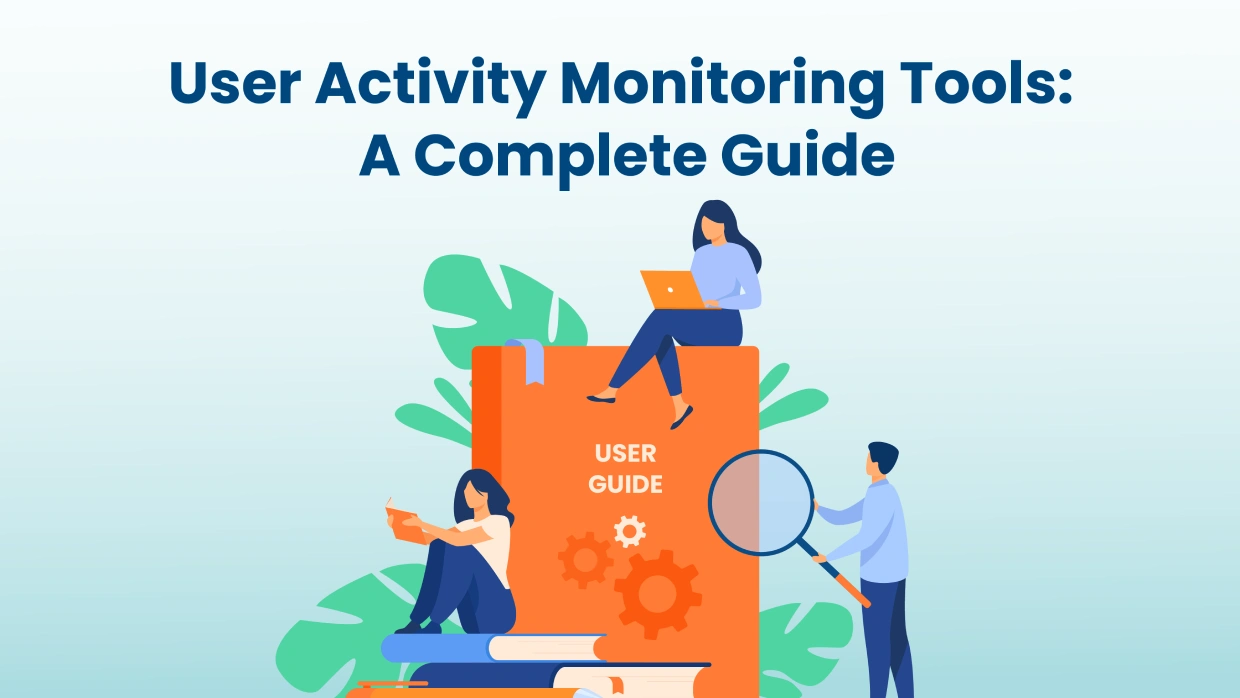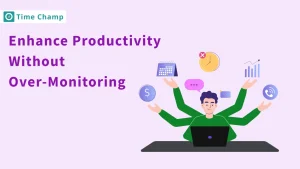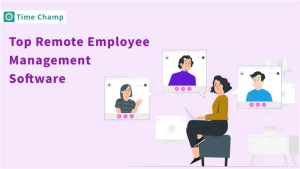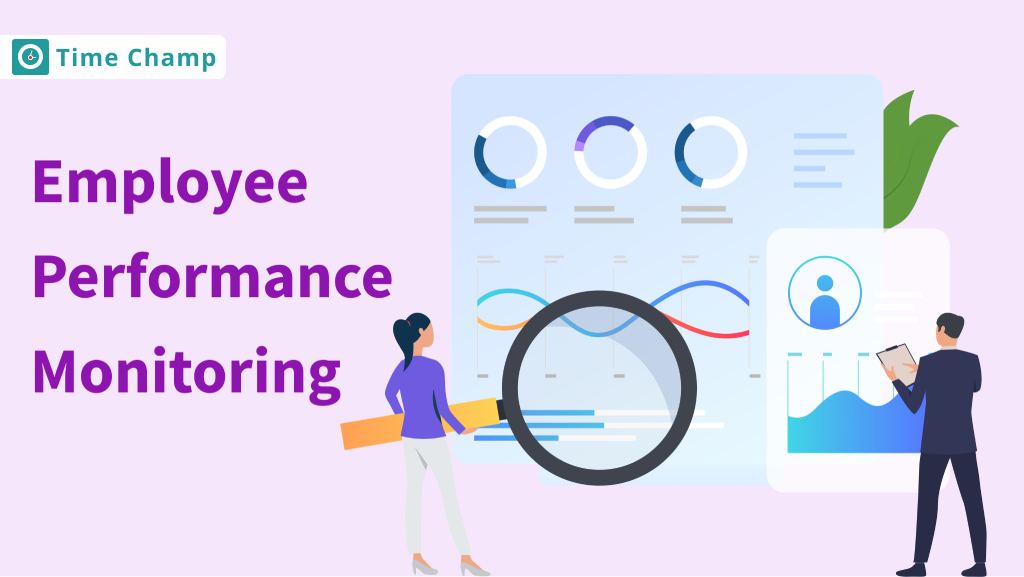User activity monitoring software is a vital tool for modern digital workplaces, which is applied by companies varying from small startups to large corporations to ensure a smooth and well-performing work environment. These technologies enable organizations to determine employee performance, and data protection, and have optimal productivity.
This brief guide focuses on user activity monitoring tools, as well as the impact they have on creating a secure and productive workplace. We will focus on their advantages, things to consider when choosing the suitable software, and the implementation procedures.
In analyzing various monitoring options, we would like you to take a closer look at Time Champ. It is a flexible tool for effective employee monitoring and performance measures. Consider Time Champ for efficient workplace monitoring.
What is User Activity Monitoring?
User Activity Monitoring (UAM) is like having a digital watchdog for your company’s computer systems. It’s a way of keeping an eye on what everyone is doing when they’re using your company’s computers, networks, and software.
UAM tracks things like which files people are accessing, what websites they’re visiting, and what applications they’re using.
But why is this important? Well, imagine you have a store with lots of valuable items. You’d want to make sure no one was sneaking around trying to steal things, right? UAM does the same thing for your digital store, making sure no one is doing anything they shouldn’t be doing.
It’s not about spying on people or invading their privacy it’s about keeping your company safe and secure. With UAM, you can catch potential security threats before they become big problems. Also, it can help you make sure everyone is following the rules and using company resources responsibly.
How User Activity Monitoring Works
For any business that values security, employee productivity, and compliance, understanding the nuances of user activity monitoring is essential. User activity monitoring is intended to offer a transparent, detailed, and actual view of how corporate resources are used. Employee activity monitoring tools are smart systems that observe employee actions, identify possible insider attacks, and ensure that employees are productive and adhere to company policies.
Detailed Activity Reports:
User activity monitoring is based on these reports. They log every action performed by a user, sometimes recording a timestamp, application use, keystroke logs, and mouse movements. This level of detail enables the identification of user patterns and potential policy violations.
Category Breakdowns:
User activity is grouped into versions based on the class of the application or the site being used. This helps in distinguishing between productive and potentially wasteful or unauthorized applications.
Timesheets:
Automated timesheets capture how many hours users spend on different tasks. This not only automates the process of tracking work hours but also identifies areas where time can be better managed.
Nonproductive App Alerts:
Alerts are created for supervisor monitoring when an employee uses too much time on unproductive applications. This direct feedback loop enables immediate intervention and discussion regarding appropriate time management.
Audio Tracking:
Audio tracking is used in some settings to quality check and monitor conversations for compliance purposes. This is especially true in industries such as customer service and finance, where verbal transactions often occur.
Using these methods, the monitoring software for user activity gives organizations the necessary tools to protect vital information and maintain a productive workforce. In essence, user activity monitoring is an integral part of modern business management, as it helps define an organized, safe, and efficient workplace.
Best Practices to Ensure User Activity Monitoring
Ensure you are following the best practices of UAM by following tips from the following steps.
1. Define Clear Objectives
Before you start using UAM, first, make your goals and objectives clear. Make a list of what you want to use monitoring user activities for, whether it’s to enhance security, ensure compliance, or improve operational efficiency.
2. Select Relevant Metrics
Make sure to note down the most important metrics and indicators that are related to your objectives. Give your attention to the activities of users that relate to the security and operations of the organization, such as file access, application use, or network connections.
3. Establish Policies and Procedures
Create a set of policies and procedures to regulate the use of UAM within your corporation. Make certain to outline the acceptable use policy, privacy issues, and the sanctions for policy breaches to guarantee transparency and responsibility.
4. Educate Users
Develop training and enlightenment courses to teach employees about UAM and its objective. Enhance the awareness of users on the responsible use of digital assets and how UAM is the key to maintaining security and compliance.
5. Implement Secure Technologies
Select UAM solutions that are designed to ensure the utmost security and privacy of data. Make sure that the technologies you have chosen are in compliance with all the regulating bodies and standards and use encryption and access controls to protect the data.
6. Monitor Effectively
Periodically review and assess collected monitoring data for identifying any pattern, trend, or possible security incidents. Apply automated alerts and notifications to enable the organization to timely respond to criminal activities and security breaches.
7. Regularly Review and Update Policies
Regularly revise and adjust UAM policies and procedures to fit the new developments in technology, law, and organizational requirements. Make sure the policies continue to be appropriate and efficient in the face of the constantly changing security challenges.
8. Maintain Transparency and Accountability
Enhance a culture that is transparent and accountable regarding UAM practice. Make the monitoring policies and procedures crystal clear to the employees and, also, build a system for handling the workers’ complaints and grievances regarding privacy and data protection.
User Activity Monitoring Tools:
User activity monitoring tools have great importance within modern IT environments, helping to secure business processes and improve the efficiency of operations. These tools can range from full security suites to specialized applications that are focused on fine-tracking and logging user proceedings, thus creating a detailed audit trail for every employee of an organization.
- Diverse Monitoring Applications
- Privileged Account Management
- Real-Time Alerts
- Automated Surveillance
Each of these tools serves a different purpose in the overall strategy of user activity monitoring and can assist companies when selecting suitable types depending on their unique needs and concerns.
Different Kinds of User Activity Monitoring Tools:
Multiple software solutions are used to track user activities that increase business productivity and compliance. The correct choice of tools is conditioned by the adequate knowledge of options. Let’s explore the diverse range of prevalent industry tools designed for user activity tracking:
1. Time Tracking
Businesses that bill by the hour or require employee time to be allocated efficiently across projects must have time-tracking software. Such tools generally have functions that track time spent on tasks, automatically generate timesheets, and connect with payroll systems. They’re a yardstick for productivity, and they are necessary for clear client billing.
2. Activity Monitoring
Activity monitoring software gives a detailed picture of how employees use their work time. They record keystrokes, take screen captures at random times, and track Web and application use. The data can be priceless for studying workflow efficiency, identifying bottlenecks, and planning employee training to increase productivity.
3. Email and Communication Surveillance
Communication surveillance is vital in many industries to keep the compliance bar high. There are various monitoring tools able to track emails, chat messages, and other forms of communication. These can prevent data leaks, and make sure that communication between inside the organization and out accords with corporate policies.
4. Location Tracking
For businesses with itinerant staff or ones that have to deal with field operations, location tracking is an important part of worker monitoring. These tools gather data on the locations of employees, which gives managers a clear picture in detail about what is going on outside. Instant feedback becomes critical for coordinating logistics, promoting customer service, and even protecting the personal safety of employees.
5. Network Monitoring
Network monitoring tools are supposed to protect an organization’s digital fringes by capturing both incoming and outgoing traffic. They can discern suspicious activities that might be warning signs of possible security threats, improper data access, or data exfiltration attempts.
6. Behavioral Analytics
Sophisticated monitoring solutions use behavioral analytics to model typical operational behavior and spot aberrations. insider threats or compromised accounts. By establishing behavioral baselines, these tools can raise flags for aberrations from normal patterns.
Look more closely at the various user activity monitoring tools at your disposal to see how you can maximize the potential of your workforce and enhance your organization’s defenses. Each tool has unique features that work in concert to improve your operational success.
Benefits of User Activity Monitoring
Now that you understand what UAM is, let’s discuss about its benefits.
User Activity Monitoring offers many benefits that contribute to the overall security and efficiency of a company’s digital environment.
1. Enhances Security
UAM performs the function of a cyber watchdog, always keeping a close eye on the users’ activities to identify any irregular behavior or possible security violations. The UAM pinpoints unauthorized access attempts or anomalous patterns, and as such, it assists in the prevention of data breaches and cyberattacks.
2. Compliance Adherence
A number of industries have regulations that cover data protection and privacy, among other things. UAM generates detailed logs and reports relevant to user activities. These can be used for compliance audits and also ensure regulatory standards such as GDPR or HIPAA are followed.
3. Insider Threat Detection
On the one hand, external threats are usually more highlighted, while insider threats might cause as much damage. UAM also provides a means of identifying and managing risks that may come from people such as employees or contractors who may accidentally or intentionally compromise security by unauthorized access or negligence.
4. Operational Efficiency
The analysis of employee work with digital resources will provide data on workflow inefficiency problems and resource underutilization. Through the examination of user activities organizations can make processes more effective, workflows more simplified and their whole operations more efficient.
5. Resource Optimization
UAM assists companies in the process of pinpointing resources that are not being utilized as well as areas of over-supply. On the basis of analyzing user behaviour, businesses can make insightful decisions about resource allocation, and this will help that resources are well used and cost-efficiently.
6. Risk Mitigation
Through the proactive analysis of user behaviour, UAM allows organizations to trace the risks and react to them before they become full-grown problems. This strategy is driven by the desire to prevent the escalation of security incidents and to minimize the occurrence of costly operations disruptions.
Key Factors to Consider for User Activity Monitoring Solutions
- Community Support: Backing from a large community means that you will always have updates, patches, and technical support from other users.
- Customizability: One of the biggest attractions of open-source software is the ability to customize.
- Security: Since open-source projects are public, anyone can take a look at them. Everybody can then pitch in on troubleshooting and thereby strengthen the security features even further.
- Scalability: The chosen solution must be scalable to the business. It should be able to efficiently manage more data and a higher number of users or endpoints without performance degradation.>
- Ease of Use: An effective system should have a good interface and overall user experience to allow staff to efficiently manage and analyze the data. An intuitive solution reduces the learning curve and operational overhead significantly.
- Integration Capabilities: The tool must fit well into current systems, like HR platforms, project management tools, and security software, to offer a comprehensive image of user activities without having to modify existing workflows and processes.
- Compliance Features: Rather, many industries are bound by regulations about user data and privacy. The suitable user activity monitoring solution must have functions enabling it to help maintain compliance with the related laws and standards.
- Reporting and Analytics: The ability to compile and interpret activity data is important to the value of user activity monitoring. The solution should provide detailed reporting and analytic features that convert raw data into operative knowledge.
- Cost: The cost of ownership, initial setup, maintenance, and any subscription fees should be within the organization’s budget and be capable of providing sufficient functionality.
- Vendor Reputation and Support: Determine the reputation of the software vendor as well as the type of support they offer. Good technical support can have a huge impact on the deployment and operational use of the monitoring solution.
Data Retention and Backup: Consider how the tool deals with data retention and backup. It helps in the availability of data for audits and historical analysis.
By taking into account these aspects, organizations can choose a user activity monitoring solution that will not only fit their current needs but also have the potential to serve their future operating objectives. This strategic method guarantees that the solution selected is a form of sustainable investment that promotes positive security and efficiency in the business.
Time Champ: A Comprehensive User Activity Monitoring Tool
Time Champ is a highly effective and reliable tool for monitoring productivity within a business to measure, track, and improve the productivity and performance of every department, team, and employee. This is an essential tool for companies that want to work with confidence and that want to plan the future growth of their companies as it will compute the productivity based on the number of work-related activities that are done during working hours.
- Employee Monitoring: Time Champ’s monitoring ability enables management to view the efficiency of the employee. It gives an overall picture of how employees spend their working hours, charting the applications used and the time spent using them. This gives an easy way to measure the levels of productivity by understanding the performance of individuals and the performance of teams.
- Activity Tracking: The tracking feature that keeps track of activity records the actual activity of employees, the active window titles, and the names of the applications running. This information is useful in determining in which areas the company’s employees perform best and which areas need attention from the company employees.
- Live Screen Recording: One more feature of Time Champ is live screen recording which allows employees to monitor their screens in real-time. This may help define what particular tasks employees are focusing on when they are at work, and it may also be a helpful tool to control compliance and safety.
- Applications and Website Tracking: Time Champ tracks every application and website accessed by employees through the time tracked during their working hours. The software can label these as productive, non-productive, and neutral and aid in software and website usage analysis so that the personnel can only be involved in tasks related to their employment.
- Customizable Productivity Definitions: Managers, HRs, and executives can outline their employees’ job roles to define productivity. Time Champ is customized for individuals, teams, and companies, where monitoring settings are tailored to fit the organization’s specific requirements and individual practices.
- Application Usage Reports: These reports indicate which applications are most used and how long they are. This can reveal time-wasting behaviors or reveal effective tools that make an employee productive.
- Productivity Apps & Websites Configuration: Time Champ gives the function to categorize applications and websites as productive or non-productive according to Company policy. With such specific requirements, costing enables accurate productivity analysis that matches the organization’s operational ecosystem.
- Individual Productivity Analysis: Time Champ carries out the fragmentary breakdown of productive, nonproductive, and neutral activities to assist management in analyzing employee activities as well as behavioral patterns. This analysis can aid in making informed decisions on training, assignment of resources, and the management of workloads.
- Time Spent:
Time Champ will allow you to see the time your employee has spent on each one of the websites. - Minute Monitoring:
Here you will have level 2 monitoring which includes the pages where the employee visited, time spent on each of those pages, and actions they took along with the clickable link. - Detailed Log:
You can catch every activity of your employees from the time they log in to when they log out and the logs are downloadable with a click of a button.
Time Champ helps organizations create a productive and effective working environment by incorporating these features. It offers a kind of middle-way monitoring that enables businesses to develop their employees while at the same time maintaining a safe and productive workplace. For more information, visit Time Champ or book a Demo today!
Conclusion
Finally, ending this foray into the world of monitoring workers ‘activities, we can see that these systems are important catalysts in productivity improvement and protection. But it’s not just a question of oversight, but about creating a workplace that is well-informed, safe, and responsible in which every employee can flourish. Deployment of monitoring software should be driven by a solid plan of action, deep familiarity with the tools at your disposal, and total integrity in implementation.
An organization must exercise a lot of foresight when choosing which monitoring software to use. For example, the choices should line up with its operational needs and the prevailing culture in the workplace. Usage tracking software will provide some major insights into application efficiency. User activity monitoring tools can watch both individual and team productivity levels closely.
Last, invest in tools that go beyond basic functionality to become your partners for excellence. On this path, Time Champ is there at your side. We provide a user-friendly and complete set of monitoring solutions. And here’s to the future of work with open arms embracing, and our tools ready.






